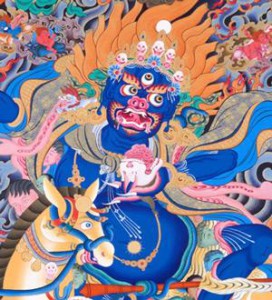Friday
Community ArticlesNew Year Limbo
Preparing for the Tibetan New Year
 This time of year is a sort of ‘new year limbo’ for Shambhalians, having just started a new Gregorian calendar year while still wrapping up the Tibetan year of the Fire Bird. Instead of trying to think of which new year is true, this is an invitation to remember that we have many opportunities for a fresh start. The Tibetan new year – which we celebrate as Shambhala Day – lands on February 16th this year. Like many new year traditions, it is a time for clearing up lingering obstacles from the previous year (such as unresolved karma or dirty closets), and for building a strong foundation for the year ahead.
This time of year is a sort of ‘new year limbo’ for Shambhalians, having just started a new Gregorian calendar year while still wrapping up the Tibetan year of the Fire Bird. Instead of trying to think of which new year is true, this is an invitation to remember that we have many opportunities for a fresh start. The Tibetan new year – which we celebrate as Shambhala Day – lands on February 16th this year. Like many new year traditions, it is a time for clearing up lingering obstacles from the previous year (such as unresolved karma or dirty closets), and for building a strong foundation for the year ahead.
The last days of a year are seen as the period when the karmic activities of that year ripen; it’s when the chickens come home to roost, so to speak. Like getting near the end of a race, we want to finish strong, not to forget our goal, or lose form. As Shambhalians, we have rituals that help us in this transition. The 10 days before a new year are considered Dön Season, a time when we are most susceptible to confusion, sickness, and disorder. During this period we don’t start new projects, but rather slow down and reflect back on where we’ve been. We also recite a chant called “Pacifying the Turmoil of the Mamos,” often simply referred to as ‘Mamo Chants,‘ which help to gather dissipated energy and restore any imbalances that have developed. The Sakyong offers some pithy guidance for dön season: “I think it would be nice annually to get into a habit where we can at least slow down for a little bit and reflect on what’s happening.”
 Then the day before the new year is called Neutral Day, which is a celebration of restoring our good nature – all the fresh cleanliness hiding beneath the layer of dust or the pile of clutter. The practices of neutral day are focused on cleaning up the environment, so we have a cleaning party to uplift our centers. This is also a good day to clean your stove and make your bed at home. Then we celebrate Shambhala Day and the new year to come: the year of the Earth Dog.
Then the day before the new year is called Neutral Day, which is a celebration of restoring our good nature – all the fresh cleanliness hiding beneath the layer of dust or the pile of clutter. The practices of neutral day are focused on cleaning up the environment, so we have a cleaning party to uplift our centers. This is also a good day to clean your stove and make your bed at home. Then we celebrate Shambhala Day and the new year to come: the year of the Earth Dog.
If you’re curious to learn more about these end-of-year practices, here are a few resources to dive deeper:
The Sakyong has some video talks available through the Shambhala Times:
https://shambhalatimes.org/2013/02/03/don-season-teachings
If you’re interested in learning more about Shambhala Day, you can read Walker Blaine’s article: “Finishing One Year, Starting Anew”:
https://shambhalatimes.org/2016/01/22/finishing-one-year-starting-anew/
Shambhala Times also has an article “Understanding Dön Season” by Russell Rogers:
https://shambhalatimes.org/2017/02/01/doing-mamo-practice
The Dorje Lopon Lodro Dorje describes the energetics of this period in a letter titled ‘Protector Principle Averting the Negativity of the Old Year:’ “The karmic forces which shape our world are both personal and collective. We are caught up in the momentum of conditions around us, for good and ill. We share virtue, exertion, beliefs, conflicting emotions, prosperity, difficulty, and sickness with our family, our community, and our country. We are continually reacting to and contributing to the general energy.” Read the rest of the letter here:
https://shambhala.org/index.php?file=2013/05/ProtectorPrinciple1.pdf
Lodro Dorje has another article on the Chronicle Project here: “On the Mamos, the Dharmapala Principle and Mahakali Vetali”:
https://chronicleproject.com/stories_172.html
Max Roberts-Zirker serves as the Deputy Director of Shambhala Boston





